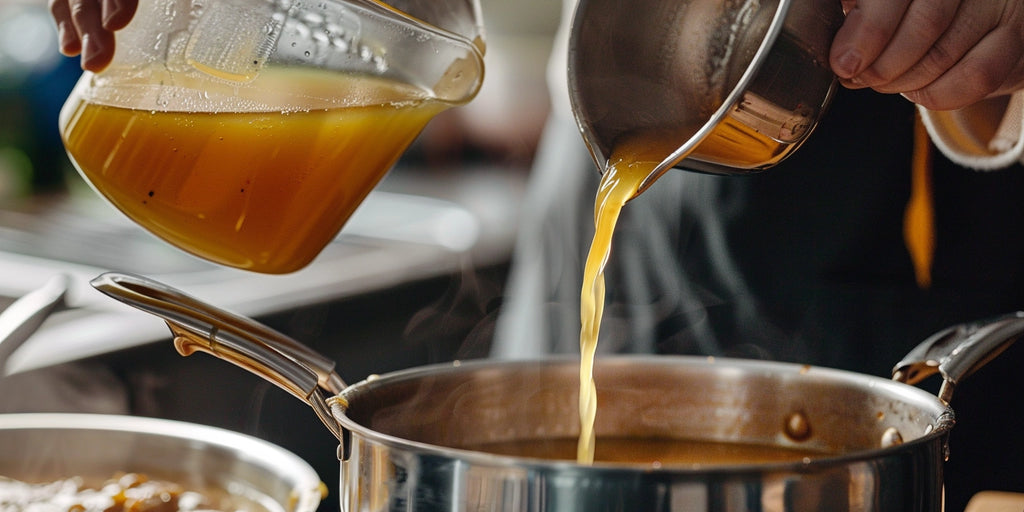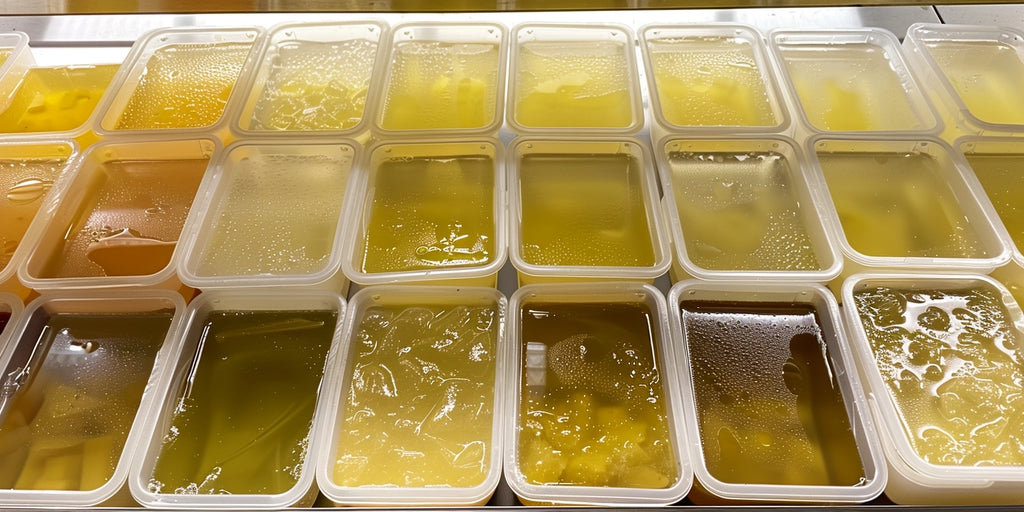Ever wondered about the difference between chicken stock and broth? You're not alone. It's a common question in the culinary world, with both having their unique roles in various recipes. They might seem similar, but there's a distinction that can significantly impact your cooking.
Chicken stock tends to be richer and more robust, made from the carcass, wings, and even feet of the chicken. It's simmered for a good long while, resulting in a thicker consistency and stronger flavor. On the other hand, chicken broth is typically lighter and more delicate, often made from the meatier parts of the chicken. It's perfect for when you need a gentle, subtle chicken flavor in your dishes.
So, whether you're whipping up a hearty stew or a light soup, understanding the difference between stock and broth can elevate your cooking to the next level. Let's dive deeper into this flavorful world.

Chicken Stock vs. Broth: Understanding the Differences
In your culinary adventures, you might have come across the terms "chicken stock" and "chicken broth" quite frequently. Understandably, this can cause a bit of confusion as the two terms are often used interchangeably. However, they are not exactly the same. Let's explore each in detail.
Definition of Chicken Stock
In traditional cooking, chicken stock is made from the carcass of the chicken. This includes the bones, wings, and sometimes feet if they're available. The stock preparation requires simmering these ingredients in water, often with vegetables like onion, celery, and carrots thrown into the mix. You'll also commonly find herbs and spices such as thyme, bay leaf, black peppercorns, and at times, even some lemon to round off the flavors.
Definition of Chicken Broth
Contrary to stock, chicken broth is more often made from the meatier parts of the chicken, including lean meat and occasionally bones for added flavor. This results in a broth with a lighter and more delicate taste compared to the rich and full flavor of stock.
Broth is ideally suited for use in soups, broths, and aspics, while stock is the go-to choice for stews and heartier dishes. Soups and aspics benefit from the clear and clean taste of broth.
Key Differences
While both chicken stock and chicken broth involve simmering chicken in water along with various vegetables and seasonings, there's a diaphanous yet distinct difference between the two:
- Stock is more bone-centered, contributing to a fuller-bodied, richer taste. It's used to provide a strong foundation in dishes such as stews and sauces.
- Broth, on the other hand, relies more on the meatier parts of the chicken bringing a softer, more delicate flavor. It's often used as a base for soups and lighter dishes.
In essence, whether you choose to make chicken stock or broth will depend on the nature of your dishes. With this knowledge, you're geared to enhance your cooking to new gourmet heights.

Benefits of Using Chicken Stock
Now that you've grasped the nuances between chicken stock and broth, let's dive into the specific benefits of using chicken stock in your culinary adventures. Incorporating chicken stock in your cooking not only leads to an incredibly rich and flavorful depth but also offers considerable nutritional benefits.
Flavor Enhancement
It's impressive how chicken stock can instantly elevate the taste profile of your dishes. This miraculous ingredient is dense, packing a punch of flavor that can transform an ordinary recipe into an extraordinary one. Chicken stock, simmered for hours with chicken carcasses, wings, and feet, infuses your meals with a robust and heartier flavor. Succulent stews, savory gravies, and delectable soups owe their complexities to the amalgamation of stock flavors.
Use chicken stock when you cook grains such as rice or quinoa, or use it to deglaze your pan when sautéing vegetables. It works magic in Bolognese sauce and even gives your stuffing a touch of tastiness. When you want a recipe to have a thicker, more flavorful base, stock is your go-to option.
Remember, if you're aiming for a savory stew or a rich soup, chicken stock offers a depth of flavor that broth can't rival.
Nutritional Value
Stock isn't just about enhancing your food’s flavor; it also comes packed with nutrition. As the stock simmers, nutrients from the chicken bones seep into it making it a healthful choice for your home cooking. Stock contains gelatin derived from collagen within the bones, an essential component for joint health. It's also filled with minerals like calcium, phosphorus, and magnesium.
Sipping on chicken stock may provide some nutrition benefits, granted it's not full of preservatives. Even drinking it on its own in cooler months can be a nourishing and comforting experience. However, always know where it's coming from, especially with store-bought stocks. Sodium content and other ingredients may vary from brand to brand, making some options healthier than others.
Embedded in this versatility and wealth of benefits, chicken stock establishes itself as an indispensable ingredient in your kitchen. Whether you're preparing a weekday dinner or gourmet feast, it certainly leaves its mark on your preparations. As with any ingredient, moderation is key, but the enriched taste and nutritional benefits are undeniable. It is an investment in taste and health you'd want to make in your culinary journey. Whether simmering a homemade batch or selecting a store-bought version, understanding these benefits empowers you to make the right cooking decisions.
Chicken stock offers more than just a backbone to your dishes. It is a testament to the fact that understanding these simple ingredients and their distinct qualities can significantly enhance your cooking skills and the flavors of your dishes. It encourages you to continue experimenting and refining your culinary technique.
Benefits of Using Chicken Broth
Chicken broth serves as a powerful tool in any cook's arsenal, bringing warmth, depth, and complexity to a wide range of dishes. Whether you're simmering rice, steaming vegetables, or crafting a comforting soup, chicken broth offers its pronounced benefits. Let's delve into some of these invaluable perks:
Convenience
Chicken broth provides a compelling convenience factor. You'll find it more time-efficient in comparison to chicken stock, which, while robust and flavorful, requires a significantly longer simmering time to extract the exact depth of flavors. Broth, typically made from chicken meat, vegetables, and spices, takes considerably less time to prepare, offering a quick and flavorful option for a multitude of dishes.
Versatility
The versatility of chicken broth is truly unbeatable. Consider it a jack-of-all-trades in the kitchen: its light, savory profile can enhance just about any recipe where water is used. So, think beyond soups; use broth to cook grains like rice, quinoa, or pasta, blanch meats, or even deglaze your pan while sautéing vegetables. What's more, chicken broth may even prove itself a preferred ingredient in recipes requiring a lighter, more watery texture like risotto or light soups.
Looking to get more creative? Make tasteful stuffing using chicken broth, or add depth to your Bolognese sauce. You can also opt for chicken broth over plain water when making gravy or stuffing - a simple swap that works wonders to enhance both taste and nutritional value. Through this culinary journey, you'll find chicken broth is not simply a valuable, but a transformative kitchen ally.
How to Make Chicken Stock
Making your own chicken stock isn't as complicated as it may seem. With a little time and a few simple ingredients, you can create a flavorful stock perfect for enhancing a range of dishes. Below we break down the process into three easy-to-follow sections: ingredients, cooking process, and storage tips.
Ingredients
Create a satisfying chicken stock by using the following:
- Carcass, wings, and feet (if available) of one chicken
- 1 large yellow onion, unpeeled and cut in half
- 1/2 head of garlic, unpeeled, halved horizontally
- 2 medium carrots, peeled and cut into chunks
- 2 celery stalks, cut into chunks
- 2 sprigs of thyme
- 1 bay leaf
- 1 tablespoon black peppercorns
- 1/2 lemon (optional)
- Salt, to taste
By sticking to these ingredients, you'll concoct a well-balanced, flavorful chicken stock.
Cooking Process
Knowing the right procedure separates a good stock from a great one.
First, you'll want to start with roasted bones and vegetables. Spread the chicken carcass and bones on a sheet tray along with the chopped onion, celery, and carrots. Roast until the bones are deeply golden brown (should take about 30 minutes).
Afterward, pour off the drippings (you can reserve them for other uses such as gravy). Add the chicken bones and vegetables to a large stock pot, followed by two sprigs of thyme, one bay leaf, and a tablespoon of black peppercorns. You'll then need to fill the pot with water until all of the ingredients are fully submerged.
Next, you allow the mix to simmer for three hours. This will draw out the flavors and nutrients, creating a rich, savory stock. Finally, season with kosher salt to taste, then strain the stock to remove all of the solid parts.
Storage Tips
After making the chicken stock, it's crucial to store properly it to ensure longevity and optimal flavor.
As a general rule, cool your stock as quickly as possible before storing to mitigate bacterial growth. You can do this by placing your pot in a sink filled with ice water, stiring until the temperature substantially drops.
Then, transfer your cooled stock to airtight containers and store in the refrigerator for up to a week, or in the freezer for up to three months. When freezing, remember to leave space in the containers for the stock to expand.
How to Use Chicken Stock and Broth in Cooking
So, you've learned all about chicken stock. You know how to make it, you understand the importance of using roasted bones and vegetables, and you're aware of how to store it properly. But how does it compare to chicken broth?
Chicken broth, unlike stock, is made from meat rather than bones. The flavor is lighter, and it's generally used as a base for soups. Stock, on the other hand, brings depth and richness to dishes, making it a go-to for sauces and stews.
Both have their place in your kitchen, and knowing when to use each can significantly enhance your cooking. Use broth when you want a light, clean taste, and opt for stock when you need a robust, hearty flavor.
Remember, the choice between stock and broth often comes down to the dish you're preparing. Happy cooking!
Common Questions
Can the chicken stock be simmered for too long?
Even though simmering the chicken stock for a longer duration can help extract more flavor and gelatin, overdoing it can result in diminishing returns. If not cooked long enough, the stock could lack in flavor and gelatin content.
Why should I use stock instead of broth?
Stock, compared to broth, typically carries a deeper flavor and a richer mouth feel, making it a healthier option. With its concentrated nature, it is an excellent choice for enhancing the taste of sauces, soups, rice, and more.
Can I leave the chicken stock to simmer overnight?
Technically, simmering stock overnight is safe as long as it's maintained above 140°F. However, applying excess heat for too long might degrade some compounds in the stock and reduce its taste.
Is chicken stock the same as bouillon?
Chicken bouillon is a concentrated version of chicken stock available in powdered or cubed form. It's easy to store and handy to use, acting as a flavor enhancer when needed.







